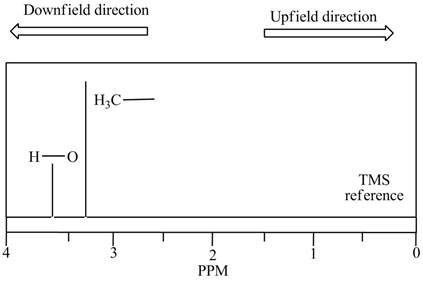
Concept explainers
The
two signals, one due to the
absorption. (b) Do the
(a)
Interpretation: The chemical shifts of the given absorptions are to be calculated.
Concept introduction: In NMR spectrum, peaks are known as resonances, lines or absorptions. On the horizontal axis, the position of absorption is generally referred to as chemical shift. The chemical shift of any absorption is calculated by the formula,
Answer to Problem 14.1P
The chemical shifts of the given absorptions are
Explanation of Solution
The observed chemical shift due to the
The observed chemical shift due to the
The operating frequency is
The conversion of
Therefore, the conversion of
Chemical shift
Chemical shift due to
The chemical shift of absorption is calculated by the formula,
Where,
Substitute the values of observed chemical shift and operating frequency in the above formula to calculate the chemical shift due to
Therefore, the chemical shift is
The conversion of
Therefore, the conversion of
Hence, the chemical shift is
Chemical shift due to
Substitute the values of observed chemical shift and operating frequency in the above formula to calculate the chemical shift due to
Therefore, the chemical shift is
The conversion of
Therefore, the conversion of
Hence, the chemical shift is
The chemical shifts of the given absorptions are
(b)
Interpretation: Whether the
Concept introduction: In NMR spectrum, peaks are known as resonances, lines or absorptions. On the horizontal axis, the position of absorption is generally referred to as chemical shift. The increasing order of chemical shift is plotted from right to left in NMR spectrum.
Answer to Problem 14.1P
The peak of
Explanation of Solution
The terms, upfield and downfield expresses the relative location of signals. The meaning of upfield is to the right and of downfield is to the left. The

Figure 1
Hence, the peak of
The peak of
Want to see more full solutions like this?
Chapter 14 Solutions
Organic Chemistry
Additional Science Textbook Solutions
General, Organic, and Biological Chemistry - 4th edition
Applications and Investigations in Earth Science (9th Edition)
HUMAN ANATOMY
Physical Science
Biology: Concepts and Investigations
- Provide the semi-developed formula of isooxazole obtained by reacting acetylacetone and hydroxylamine.arrow_forwardGiven a 1,3-dicarbonyl compound (R1-CO-CH2-CO-R2), indicate the formula of the compound obtaineda) if I add hydroxylamine (NH2OH) to give an isooxazole.b) if I add thiosemicarbazide (NH2-CO-NH-NH2) to give an isothiazole.arrow_forwardAn orange laser has a wavelength of 610 nm. What is the energy of this light?arrow_forward
- The molar absorptivity of a protein in water at 280 nm can be estimated within ~5-10% from its content of the amino acids tyrosine and tryptophan and from the number of disulfide linkages (R-S-S-R) between cysteine residues: Ε280 nm (M-1 cm-1) ≈ 5500 nTrp + 1490 nTyr + 125 nS-S where nTrp is the number of tryptophans, nTyr is the number of tyrosines, and nS-S is the number of disulfide linkages. The protein human serum transferrin has 678 amino acids including 8 tryptophans, 26 tyrosines, and 19 disulfide linkages. The molecular mass of the most dominant for is 79550. Predict the molar absorptivity of transferrin. Predict the absorbance of a solution that’s 1.000 g/L transferrin in a 1.000-cm-pathlength cuvet. Estimate the g/L of a transferrin solution with an absorbance of 1.50 at 280 nm.arrow_forwardIn GC, what order will the following molecules elute from the column? CH3OCH3, CH3CH2OH, C3H8, C4H10arrow_forwardBeer’s Law is A = εbc, where A is absorbance, ε is the molar absorptivity (which is specific to the compound and wavelength in the measurement), and c is concentration. The absorbance of a 2.31 × 10-5 M solution of a compound is 0.822 at a wavelength of 266 nm in a 1.00-cm cell. Calculate the molar absorptivity at 266 nm.arrow_forward
- How to calculate % of unknown solution using line of best fit y=0.1227x + 0.0292 (y=2.244)arrow_forwardGiven a 1,3-dicarbonyl compound, state the (condensed) formula of the compound obtaineda) if I add hydroxylamine (NH2OH) to give an isooxazole.b) if I add thiosemicarbazide (NH2-CO-NH-NH2) to give an isothiazole.arrow_forwardComplete the following acid-base reactions and predict the direction of equilibrium for each. Justify your prediction by citing pK values for the acid and conjugate acid in each equilibrium. (a) (b) NHs (c) O₂N NH NH OH H₁PO₁arrow_forward
- 23.34 Show how to convert each starting material into isobutylamine in good yield. ཅ ནད ཀྱི (b) Br OEt (c) (d) (e) (f) Harrow_forwardPlease help me Please use https://app.molview.com/ to draw this. I tried, but I couldn't figure out how to do it.arrow_forwardPropose a synthesis of 1-butanamine from the following: (a) a chloroalkane of three carbons (b) a chloroalkane of four carbonsarrow_forward

 Principles of Instrumental AnalysisChemistryISBN:9781305577213Author:Douglas A. Skoog, F. James Holler, Stanley R. CrouchPublisher:Cengage Learning
Principles of Instrumental AnalysisChemistryISBN:9781305577213Author:Douglas A. Skoog, F. James Holler, Stanley R. CrouchPublisher:Cengage Learning

